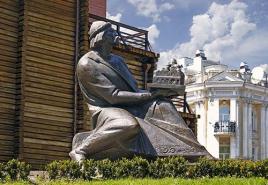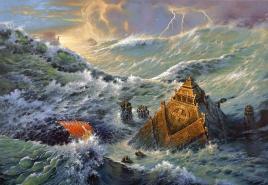Rastrelli Smolny. Smolny Cathedral
The Smolny Monastery in St. Petersburg was built according to the design of Bartolomeo Francesco (Bartholomew Varfolomeevich) Rastrelli (1700-1771), an Italian by birth who became a great Russian architect. This monastery is called “the best pearl in Rastrelli’s work” and “the most Russian of his works.”
Its main building is the Resurrection Cathedral, uniquely beautiful, rivaling the outstanding masterpieces of world architecture, the best of all that was created in the Russian Baroque. Even the architect Giacomo Quarenghi, who did not like Baroque, took off his hat when passing by the Smolny Monastery Cathedral: “What a temple!”
The Smolny Monastery was founded on the eve of her 40th birthday by Empress Elizaveta Petrovna. There, in peace and quiet, she hoped to end her stormy life. Elizabeth conceived the idea of building a monastery of unprecedented beauty and grandeur, which would become a worthy monument to her prosperous 20-year reign. She intended to become the abbess of this monastery and live in a special, spacious house, surrounded by 120 girls from noble families, and for each of them a “separate apartment” was to be built. And the Smolny Monastery began to be called after the Smolyany Dvor located nearby since the time of Peter the Great, where tar was boiled for the needs of the young Russian fleet.
.jpg)
In the original version of the project, the Resurrection Cathedral was conceived to have a single dome. However, in July 1749, Elizabeth ordered the already completed project to be remade: the main temple was to be built “not according to the Roman style,” but in the image and likeness of the Assumption Cathedral of the Moscow Kremlin, and the bell tower should be “like the Ivanovo Tower here.” That is, it was necessary to build a traditional rectangular Russian temple with a five-domed structure, which Peter the Great abandoned in favor of European fashion. Elizabeth, who expelled everything German and asserted her own, Russian, believed that the external appearance of the monastery should personify the inviolability of Orthodoxy and the eternity of the national spirit.
The construction of the Smolny Monastery, which lasted from 1748 to 1769, was preceded by work with the model. Its parts were assembled in the same sequence in which the monastery was later built: first the eastern body of the cells, then the northern, southern, then the fence, turrets and, finally, the cathedral. Thus, the main temple of the monastery - the Resurrection Cathedral - was inscribed in a cross made up of cells, a refectory, a library, the abbess's chambers and four churches located in the corners near the fence. The beauty of the temple could be seen from any point of the monastery territory, the center of which it was.

The plan of the cathedral resembles a Greek cross. Its main parabolic dome seems to grow from a powerful drum cut through by huge windows. Four two-tier turrets, crowned, like the central dome, with onion-shaped domes, almost closely attached to the drum, forming a compact picturesque silhouette. The facades of the building are distinguished by their extraordinary elegance and plasticity of shape, while no facade is similar to the other and reveals its beauty depending on the lighting of each side. The architectural design of the cathedral creates an unusual illusion of its size. As you approach, the cathedral visually becomes smaller, without losing its majesty.
By 1757, the cathedral was almost ready, but work stopped due to the Seven Years' War. Catherine the Second, who ascended the throne in 1762, abandoned Rastrelli’s plan to build a bell tower, and this architectural masterpiece remained only in the model, now stored in the Museum of the Academy of Arts in St. Petersburg. Since 1762, the decoration of the cathedral was carried out by architect Yu.M. Felten. He completed the construction of the ensemble already in the 1830s. V.P. Stasov, who treated the original project with care. He formalized the entrance to the monastery and finished decorating the interior, which, however, turned out to be much more modest than Rastrelli had intended. At that time, classicism was already dominant, so the decoration did not have the luxurious gilded carvings characteristic of the Baroque, paintings saturated with bright colors, or an abundance of fancy leaves, flowers and fruits. In the interior decor, Stasov limited himself to a stucco frieze, spectacular capitals of columns of the Corinthian order and stucco belts on the dome drum. The light coloring of the walls and the restraint of the decor especially emphasize the extraordinary lightness and upward direction of the light-filled space. It seems that the light arches do not support the vault, but, on the contrary, carry four pylons upward and lift the drum of the high dome. The huge church hall with three majestic iconostases was decorated in marble. A balustrade made of cut crystal was installed in front of the altars (a balustrade is a fencing for balconies, staircases, galleries, roofs, consisting of a number of balusters connected at the top by a handrail). The pulpit was decorated with exquisite carvings. Currently, among the relics of the temple, the icons of A. Venetsianov “The Resurrection of Christ” and “The Presentation of the Blessed Virgin Mary into the Temple” have been preserved.
In terms of the expressiveness of its compositions, its interior decoration and picturesqueness, the Smolny Cathedral is rightfully one of the pinnacles of world architecture. It began to be built by the great architect Francesco Bartolomeo Rastrelli during the reign of Empress Elizabeth Petrovna, and the construction was completed by the architect V.P. Stasov under Emperor Nicholas I.
Background to the construction of the cathedral
On the site where the Smolny Cathedral is now located, in the Middle Ages there was the village of Spasskoye, which took its name from the church of the same name. Then this land belonged to Veliky Novgorod. But during the rule of the Swedes, the church was completely destroyed. And after the founding of St. Petersburg, a resin yard was built on the site of the church, where resin was boiled for the needs of the flotilla. Nearby is the Smolny Summer Palace, where the daughter of Peter I, Elizabeth, spent the happy days of her youth.

History of the Smolny Cathedral
But in 1774, during a fire, one wing of the palace was completely destroyed. Having ascended the throne, Empress Elizabeth ordered the construction of the Resurrection Novodevichy Monastery on the territory of the Summer Palace and the Smolny Courtyard. At that time, the Empress wanted to end her days in peace and quiet, devoting the rest of her days to serving God. The monastery was supposed to be designed for one hundred and twenty girls of noble birth. Each had its own apartments, which would include a maid's room, a separate kitchen and a storage room. She planned a separate house for herself. Construction was entrusted to the famous Italian architect Rastrelli. Elizaveta Petrovna wanted the Smolny Monastery Cathedral to resemble the Assumption Cathedral in the Moscow Kremlin. Therefore, the Empress was instructed to build the Smolny Cathedral according to all the canons of Orthodoxy - the cathedral was to be crowned with a five-domed structure. It should be noted that in the time of Peter I they did not build this way. According to Rastrelli's idea, the monastery complex was supposed to be in the form of a cross, formed by residential buildings in which the nuns' cells were located. The Smolny Cathedral was to become the center of the monastery complex. The cathedral is designed for six thousand parishioners. This is a truly majestic structure - the dome is raised to a height of 92 meters. It is picked up by four domes of small belfries. The entire monastery complex was more like a palace in its decoration: gilding, bright paint in two colors, and many decorative elements create a festive, majestic mood. But not all of the plans were realized by the famous architect of the Baroque era. Rastrelli also planned to build a 140-meter bell tower, which was supposed to be the tallest structure in Europe. But the empress’s desire to take monastic vows quickly passed, and besides, the war with Prussia began, the construction of the cathedral was curtailed. The construction of the Smolny Cathedral became one of the largest long-term construction projects - it was planned to complete it in ten years, but in reality it dragged on for 87 long years. After the end of the war, the tastes of the court changed, and the opulent Baroque style was replaced by a more restrained classicism. The construction was completed by architect Stasov. After the revolution, the cathedral was looted and closed. It began to be used as a warehouse, and the cathedral square was named Rastrelli.

Architecture
The monastery complex is a cross, in the center of which rises the dome of the Smolny Cathedral. There are four churches in the corners. The architecture of the complex is made in the Baroque style, as evidenced by the arched pediments and lucarnes. The walls of the cathedral are painted soft blue and the domes gray. The main dome of the Smolny Cathedral is helmet-shaped, which is crowned with a bulbous dome. This dome is much larger in size than the four secondary domes. The four bell towers consist of two tiers and have a concave shape. Each bell tower ends with an onion dome. In the second tier of bell towers there are belfries. The lower facade of the cathedral in its splendor is more like a palace - openwork, as if floating above the ground. Four house churches are located in the corners of the monastery, as if they were built into the wall. Each church has a dome with a cross. Thanks to the skill of the architect, an unusual illusion is created: as you approach the cathedral, it seems as if it is decreasing in size, without losing its grandeur. Particular attention should be paid to the forged fence surrounding the monastery complex. This is a real work of art, created by the architect Stasov, who completed the construction of the cathedral.

The Cathedral today
The Smolny Cathedral (St. Petersburg) received its second life in 2009. On the twenty-fourth of May, after a long break, the first prayer service was held here, conducted by Bishop Ambrose of Gatchina. And a year later the cathedral opened its doors to parishioners. Divine services began to be held there again. But part of the cathedral building still belongs to the city authorities. Classical music concerts are held here. Organize exhibitions.
Concert and exhibition complex
Thanks to amazing acoustics, the concert hall of the Smolny Cathedral is always full. There are concerts of organ music, a concert by Antonio Vivaldi “The Seasons”, a concert by Sergei Prokofiev, and dance and folk music. Family-friendly concerts are held on Sundays. A chamber choir regularly performs on the cathedral stage. You should definitely visit the exhibition hall of the Smolny Cathedral. Exhibitions are held here representing the culture and life of the peoples inhabiting the Leningrad region, the history of its cities and great people. Conferences, seminars, and round tables take place against the backdrop of exhibitions.

Smolny Cathedral. Address
Location: St. Petersburg, sq. Rastrelli, no. 1-3.
The nearest metro station is Chernyshevskaya. But it’s quite a long walk from the station, and transport is bad. Therefore, it is better to get to the Ploshchad Vosstaniya station. Coming out of the metro, turn left along Ligovsky Prospekt. Walk to the Oktyabrsky Concert Hall. Here take minibus No. K-76 and get to Sq. Rastrelli.
The blue and white ensemble of the Smolny Monastery with the airy five-domed cathedral in the middle is perhaps the most elegant religious building in our city. And yet, it is with him that some rather dark urban legends are associated. It took 87 years to build the cathedral, over the next 87 years services were held in it, and for another 87 years it stood ruined.
Smolny Cathedral. © Photobank Lori
Place of prayer
It is believed that in ancient times, in a bend of the Neva, on lands belonging to Veliky Novgorod, the village of Spas was located, and on the site of the current cathedral there was a temple. After the founding of St. Petersburg, the “Smolny Dvor” was built here - they cooked ship tar for the Admiralty shipyards. During the time of Anna Ioannovna, the Summer Palace, also called the Smolny House, was erected nearby. Having ascended the throne, Elizaveta Petrovna ordered the founding of the Resurrection Convent, where she intended to retire in old age. Construction was entrusted to the great architect Francesco Bartolomeo Rastrelli, who began work in 1748. However, the empress’s plans were not destined to come true; she died without taking monastic vows. In the 1760s, Catherine II established the Smolny Institute for Noble Maidens, the first women's educational institution in Russia, in the former monastery (which was such until 1797). At the beginning of the 19th century, the Institute was moved to a building specially built for it next door.
Smolny Monastery. Color lithography. Mid-19th century
Main temple of educational institutions
After construction, which was completed only in 1835,Smolny Cathedral became the main temple of educational institutions. Contrary to the original plan to build a single-domed temple, Rastrelli yielded to Elizabeth and designed a five-domed cathedral, echoing the Assumption Cathedral of the Moscow Kremlin. The entire ensemble is designed in the magnificent style of Elizabethan Baroque. According to legend, even the architect Giacomo Quarenghi, a fan of strict classical lines, recognized the perfection of the forms of the Smolny Cathedral. “This is a temple!” - he allegedly exclaimed as he passed by. And he took off his hat.
The building of the monastery is a Greek cross. The height of the cathedral is 93.7 meters.

Concert hall. © Photobank Lori
Ghosts of the Smolny Monastery
Not a single church in St. Petersburg took as long to build as the Smolny Cathedral. It was founded in 1735 by the architect B.F. Rastrelli under Elizaveta Petrovna, and completed only in 1835 by V.P. Stasov. The reason for such long-term construction was the change of power, as well as successive wars, which required large financial expenditures from the state.However, St. Petersburg residents were sure that a curse had been placed on the cathedral. It was said that during construction work, a worker hanged himself in the belfry (other sources mention an assistant to the architect, a pharmacist who lived next door, or a deceived contractor). Since then, the ghost of a suicide has in every possible way prevented the completion of construction.
Smolyankas, who first settled in the monastery and then moved to the building next door, claimed to have met the White Lady walking along the corridors of the Institute or around the cathedral.
And employees of institutions that found refuge in the monastery after the revolution said that sometimes, late at night, a late employee would sometimes meet in the vaulted corridor an inconspicuous person with a briefcase in his hands, who, stepping aside, suddenly disappeared into a blank wall.

View from the belfry of the cathedral. © Photobank Lori
Invisible bell tower
According to the architect Rastrelli, a 140-meter bell tower should have risen next to the cathedral. If the project had been implemented, the bell tower of the Smolny Cathedral would have become the tallest building in Europe in the 18th century.However, Rastrelli later abandoned this idea, and due to the outbreak of the Seven Years' War, construction funding was severely cut. However, the workers managed to lay a powerful foundation, which archaeologists discovered at a depth of 4 meters.
A model of the monastery with a non-existent bell tower can be seen in the Museum of the Academy of Arts. And townspeople say that in the St. Petersburg autumn fog you can sometimes discern the features of a non-existent bell tower.

Old postcard. © Photobank Lori
Modernity
In 1922, the temple was closed and destroyed. Only the icon of the Virgin Mary painted by A.G. Venetsianov has survived, the original of which can be seen today in the Russian Museum. Another urban legend claims that the crystal balustrade of the cathedral was used in the design of the Avtovo metro station. In 1990, a concert and exhibition hall was opened in the cathedral. The first service took place in 2009, and since 2011, church services have been regularly held in the temple.The monastery, to some extent, continues the traditions laid down by Catherine the Great: already in the 21st century, educational institutions are located here - the Faculty of Sociology, the Faculty of International Relations, the Faculty of Political Science of St. Petersburg State University.
Today, everyone can climb the belfry to check for the presence of that same ghost. Or to see a panorama that will take your breath away.
The cathedral complex is located on the left bank of the river. Smolny Cathedral is designed in Baroque style. Here you can observe a combination of European architecture and Russian architecture. The height of the monastery reaches almost 94 meters, which only emphasizes its greatness.
History of the construction of the cathedral
The history of the appearance of this architectural monument goes back to 1740, when the current Empress Elizaveta Petrovna decided to leave the throne and go to a monastery. Elizabeth decided to erect monastery walls on the territory where the house in which she spent her youth stood. In addition to the monastery itself, the empress planned to build a bell tower, house churches and an institute for young girls who have noble roots. 
Smolny Cathedral, whose architect was F.B. Rastrelli, began construction in 1748. But the unexpected outbreak of war forced construction to be postponed indefinitely. Due to a lack of funding, construction work progressed very slowly. The architect V.P. Stasov managed to complete the construction of the Smolny Cathedral in 1835.
In 1922, all the property of the church was confiscated, which ultimately led to the closure of the Smolny Monastery Cathedral in St. Petersburg in 1923. However, a few years later it was finally opened, while other churches remain closed today. In 1990, the main event was the opening of the concert hall, which is still in operation today.
Smolny Cathedral in St. Petersburg – video
Opening hours of the Smolny Cathedral
In St. Petersburg, the Smolny Cathedral is located far from the historical center of the city, so many tourists simply do not get to this amazing place. The cathedral stands in a very picturesque place near the embankment.
You can get to the cathedral by metro. To do this, you need to get to the Chernyshevskaya station. However, the path to the cathedral from the station is not close. Therefore, it is better to use minibus number K-76, which will take you directly to Rastrelli Square.
When visiting the Smolny Cathedral, you need to check the opening hours. In summer, the cathedral is open daily from 10.00 to 19.00. On Wednesday the cathedral is closed to visitors. In winter, the cathedral opens at 11.00 and closes at 19.00. Wednesday is still the only day off. Entrance to the temple is free.
When going to the Smolny Cathedral, you also need to know the schedule of services. The morning divine liturgy begins every day at 7 am. The end of the evening liturgy is at 20.00.
No less beautiful, popular and majestic is the Kazan Cathedral in St. Petersburg. A large number of tourists visit it every day, enjoying a touch of beauty.
View of the cathedral today

The Cathedral of the Smolny Monastery in St. Petersburg today has retained its original appearance. The walls are painted in white and blue tones. The cathedral complex includes:
- Four churches that are located around the temple;
- Living spaces decorated with magnificent arcades;
- House churches;
- Four bell towers.
Initially, the architect Rastrelli, who was involved in the construction of the cathedral, wanted to build a single-domed temple. However, Empress Elizabeth insisted that the church be five-domed. As a result, they came to a compromise and built a temple with one large dome and four small domes that serve as bell towers. These four domes have two tiers. The belfry itself is located on the lower tier.
One of the main attractions of the cathedral is the openwork fence of extraordinary beauty. This fence is a highly artistic work of art, created according to the design of the architect Stasov. 
The interior decoration of the Smolny Monastery Cathedral in St. Petersburg has a majestic appearance. The hall in which daily services are held is decorated with marble. There is a crystal balustrade at the altar. In our time, the main icons with which the main hall of the cathedral is decorated are preserved in the temple. These are the original icons of “The Resurrection of Christ” and “The Entry of the Blessed Virgin Mary into the Temple.”
In St. Petersburg, the Smolny Cathedral is considered a great architectural monument. Nowadays, concerts and exhibitions related to the history of the city are held here. In addition, exhibitions of arts and crafts are organized here.
Smolny Cathedral in St. Petersburg its entire history was haunted by the number 87: it was built for so long, services were performed in it for so many years, and it stood for the same amount of time without being used for its intended purpose. It’s worth coming here to have an association with the word “Smolny” that is different from the one to which everyone is accustomed.
Contacts
How to get to Smolny Cathedral
To get to the temple, you will have to prepare to make 2 transport transfers or about 30 minutes. walk from the metro. The starting points are the Chernyshevskaya or Ploshchad Vosstaniya metro stations.
- In the first case you will have to transfer to trolleybus No. 15 or bus No. 22, 46;
- In the second– by trolleybus No. 5, 7 or bus No. 22.
Visit. Operating mode
- Since the temple recently, in 2016, became part of the Russian Orthodox Church, its operating hours have changed. Now there are no days off, and the Smolny Cathedral in St. Petersburg receives visitors from 7:00 to 20:00 (the reference point is evening service).
- In addition to services, excursions are also offered: by reservation or three times a day on weekends, at 13:00, 14:30 and 16:00. For the excursion you will have to leave a donation of approximately 200 rubles. (there are discounts for students).
- As before, you can climb the belfry of the Smolny Cathedral, which is considered one of the best observation platforms in the city.
- Opening hours of the observation deck of the Smolny Cathedral are 11:00–18:00. For visiting the belfry they also ask for a donation of 150 rubles. (there are discounts for students). All donated funds are used for restoration work on the interior of the cathedral.
Schedule of services of the Smolny Cathedral
You can attend services in the cathedral any day of the week. Except that the early morning liturgy (7:00) can only be heard on weekends and holidays.
The regular schedule of services is as follows:
- 9:30 – late liturgy, after which the Psalter is read;
- 14:00 – prayer service;
- 16:00 – memorial service;
- 17:00 – evening service.
The schedule of services is adjusted only in connection with major holidays or fasts.
Where can you stay nearby?
Specifically, there are no pilgrimage hotels near the Smolny Cathedral in St. Petersburg, but in the surrounding area, 2 km from the temple, you can choose a place in a dozen hotels/hostels. If you really want to stay in a pilgrimage hotel, there are three of them near the Alexander Nevsky Lavra, on the embankment of the Monastyrka River: "Iris","Dukhovskaya" And "Feodorovskaya".
The cost of staying in hotels starts from 500 rubles/day.
The history of the creation of the Smolny Cathedral in St. Petersburg
- The name of the future cathedral was determined by its location. Even in the time of Peter I, resin was produced at this site for the construction of shipyards, and the Smolny Palace was located nearby, where the Tsar’s daughter, Elizabeth, was raised. When the idea came to her to take monastic vows, to build a monastery for herself and 120 young ladies of eminent families, she indicated the location of these Smolny courtyards.
- The design of the Resurrection Novodevichy Convent was entrusted to the courtier architect F. Rastrelli, and the first stone was laid with celebration and cannon fire in 1748. Rastrelli had many plans (even a wooden model of the monastery complex in the Academy of Arts was preserved); he wanted to get rid of the defensive walls familiar to monasteries and make the bell tower at the gate the main accent. But the empress intervened in the construction. Now the bell tower had to be shortened, and in addition to the large dome on the Smolny Monastery Cathedral in St. Petersburg (it was renamed from Novodevichy), its neighbors appeared - four smaller domes (though there are two-tier bell towers under them).
- The architect did not live to see the completion of his masterpiece, so other craftsmen had to complete the baroque temple. Yu. Felten And V. Stasov. Elizaveta Petrovna herself did not have time to see the consecration of the cathedral. The domes were not completed, the walls were not plastered, and the interiors were not completed.
- By decree of Nicholas I, he worked for three years to complete the complex Stasov. He did a great job, but the Smolny Monastery Cathedral had to wait too long for its opening, as many as 87 years.
- In 1835 The cathedral was finally dedicated, giving the title of the cathedral of educational institutions of St. Petersburg. It was closed in 1923, using the premises as warehouses and an atomic bomb-proof bunker. By 1974, there was no longer an iconostasis or valuables inside, but there was a historical museum. The liturgy was allowed to be held within the walls of the cathedral only in 2010; icons, a cross and a bell were brought. The Smolny Cathedral changed its museum status to a religious one only in 2016.
Architectural and cultural landmarks
- The style of the entire Rastrelli complex can be designated by the word “Baroque”, although with impurities. After all, the court architect was famous for his style in architecture, which is why the cathedral looks baroque, no matter where you look at it (in European buildings only one baroque façade was practiced). It is clear that thanks to the stucco and blue walls present everywhere, the architect managed to get rid of the oppressive atmosphere of Russian monastery buildings, his ideas brought lightness to the exterior of the cathedral. And the conversion of the cathedral into a five-domed one at the request of Elizaveta Petrovna is a tribute to Russian tradition, because in the minds of Orthodox believers there was an image of a five, consisting of Christ and 4 evangelists. The Smolny Cathedral is quite a bit inferior in height.
- Bell tower of Smolny Cathedral attracts tourists with its views: you can see the Neva, the Smolny Institute, the Smolny Monastery, excavations on the site of the Swedish fortress Nyenschanz taken by Peter and other interesting things of St. Petersburg. Although the bell tower is tall, judging by Rastrelli’s museum model, it was planned to be 5-tiered and 140 meters high, that is, taller than all European buildings. Bells could hang in the three upper tiers, and a cross would crown the belfry. However, there were two “buts”: under martial law (the Seven Years’ War was going on), there was nowhere to get funds, and the architect realized that he had gone too far with his ambitions, and left the Smolny Cathedral as the tallest building of the monastery complex.

- Smolny Cathedral Garden in principle, it is a square sandwiched between Rastrelli Square, Quarenghi Lane, Smolny Street and Smolnaya Embankment. It features 4 identical fountains, launched in 1934: two bowls in front of the cathedral building and two behind it. The fountains are separated by flower beds. Benches, alleys, cherry blossoms - everything is clean and well-groomed.

Shrines and photos of the Smolny Cathedral
Value can be called iconostasis Smolny. The Baroque shrine adorned the temple until 1972, when it was ordered to be dismantled. Of all the icons that adorned that same ancient iconostasis, only two icons by the court painter A. Venetsianov, depicting entrance to the Church of the Blessed Virgin Mary And resurrection of Christ, which are the shrines of the temple.
But he has everything ahead: after returning to the church’s possession, it is possible that valuable and rare icons will once again decorate the iconostasis of the Smolny Cathedral.
 Adjacent to the azure cathedral is the former Smolny Institute for Girls, where the administration of St. Petersburg now sits.
Adjacent to the azure cathedral is the former Smolny Institute for Girls, where the administration of St. Petersburg now sits.  It is noticeable, despite the iconostasis, that quite recently this place was museum property.
It is noticeable, despite the iconostasis, that quite recently this place was museum property.
Smolny Cathedral - video
Historical walk through the Smolny Monastery and the Resurrection Smolny Cathedral. Enjoy watching!!!
The Smolny Cathedral has experienced a lot, and the time of its complete return to life is still ahead. Were you, dear readers, able to feel this within its walls? We look forward to your stories and impressions.







